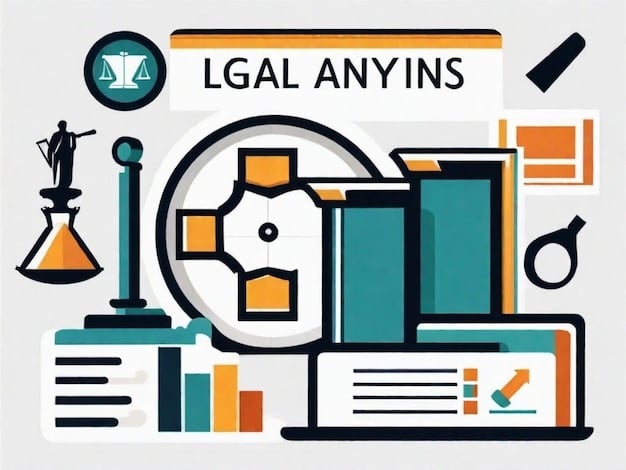Navigating New US Regulations: A Smart Contract Development Guide

The Impact of New US Regulations on Smart Contract Development: What Developers Need to Know involves understanding the evolving legal landscape, ensuring compliance, and adapting development practices to mitigate risks and foster innovation.
The increasing scrutiny from US regulators is significantly shaping the landscape for the Impact of New US Regulations on Smart Contract Development: What Developers Need to Know. Developers must stay informed and adapt their practices to ensure compliance and mitigate potential risks.
Understanding the Regulatory Landscape for Smart Contracts in the US
The regulatory environment for smart contracts in the US is still evolving. Various federal and state agencies are beginning to assert their authority over blockchain-based technologies, including smart contracts. Understanding this landscape is crucial for developers.
Federal Regulatory Bodies
Several federal agencies play a role in regulating smart contracts. These include the Securities and Exchange Commission (SEC), the Commodity Futures Trading Commission (CFTC), and the Financial Crimes Enforcement Network (FinCEN). Each agency has its own interpretation of how existing laws apply to smart contracts.
The SEC focuses on whether a smart contract constitutes a security offering. The CFTC is concerned with smart contracts used for trading commodities. FinCEN, on the other hand, is interested in smart contracts that facilitate money transmission.
State-Level Regulations
In addition to federal regulations, various states are also enacting laws related to blockchain and smart contracts. Some states are taking a proactive approach by creating regulatory sandboxes, while others are focusing on clarifying the legal status of smart contracts.
- Wyoming: Recognized DAOs as legal entities, providing a legal framework for smart contract-based organizations.
- Delaware: Amended its General Corporation Law to allow corporations to use blockchain technology for record-keeping and shareholder communications.
- California: Introduced legislation to define smart contracts and their legal validity.

Keeping abreast of both federal and state regulations is essential for developers to ensure their smart contract applications are compliant and avoid legal pitfalls. Compliance strategies must be adaptable to the changing regulatory environment.
Key Aspects of US Regulations Affecting Smart Contracts
Several key aspects of US regulations directly affect how smart contracts are developed, deployed, and used. These include securities laws, commodities laws, anti-money laundering (AML) rules, and data privacy regulations. Understanding these aspects is critical for developers.
Securities Laws and Smart Contracts
The SEC has taken the position that many digital assets offered through smart contracts are securities. This means that smart contract offerings must comply with securities laws, including registration requirements and disclosure obligations. Failure to comply can result in significant penalties.
A key issue is whether a smart contract-based token offering meets the definition of a security under the Howey Test. This test examines whether there is an investment of money in a common enterprise with the expectation of profit primarily from the efforts of others.
Commodities Laws and Smart Contracts
The CFTC regulates commodity derivatives, including those traded through smart contracts. If a smart contract facilitates the trading of commodity derivatives, it must comply with CFTC regulations. This includes registration and reporting requirements.
- Derivatives Regulation: Smart contracts that enable the trading of futures, options, or swaps need to adhere to CFTC rules.
- Enforcement Actions: The CFTC has been actively monitoring and taking enforcement actions against unregistered platforms offering commodity derivatives via smart contracts.
- Compliance: Developers must ensure their platforms are compliant with CFTC regulations to avoid legal repercussions.
Smart contracts used in the commodity derivatives space must ensure compliance with CFTC regulations to avoid legal repercussions. Developers should seek legal counsel to understand the specific requirements that apply to their projects.

Practical Implications for Smart Contract Developers
The regulatory landscape has significant implications for smart contract developers. Developers must incorporate legal considerations into their development process, from the initial design to deployment and ongoing operation. Here are some practical steps to consider:
Implementing Compliance by Design
Compliance by design involves building regulatory compliance into the smart contract itself. This includes incorporating features that ensure compliance with securities laws, commodities laws, and AML rules.
For example, a smart contract could include KYC/AML checks to verify the identity of users and prevent money laundering. It could also include features that restrict access to the contract based on regulatory requirements.
Due Diligence and Legal Consultation
Performing due diligence on the legal and regulatory aspects of a smart contract is essential. This includes consulting with legal experts to understand the specific regulations that apply to the contract and to ensure that the contract is compliant.
Developers should also conduct a thorough risk assessment to identify potential legal risks and develop strategies to mitigate those risks. This may involve modifying the design of the contract or implementing additional compliance measures.
Staying Updated on Regulatory Changes
The regulatory landscape for smart contracts is constantly evolving. Developers must stay updated on the latest regulatory changes and adapt their practices accordingly. This includes monitoring regulatory developments, attending industry events, and consulting with legal experts.
Developers must proactively monitor the regulatory environment and incorporate necessary changes into their smart contract applications to maintain compliance and avoid legal challenges. Staying informed is key to long-term success.
Strategies for Compliance and Mitigation of Legal Risks
To effectively navigate the regulatory landscape, smart contract developers need to adopt proactive compliance strategies and implement measures to mitigate potential legal risks. This involves integrating legal considerations into the development lifecycle and establishing robust monitoring mechanisms.
Incorporating KYC/AML Procedures
Integrating Know Your Customer (KYC) and Anti-Money Laundering (AML) procedures is crucial for compliance, especially in decentralized finance (DeFi) applications. These procedures help verify the identity of users and prevent illicit activities.
Smart contracts can be designed to automatically enforce KYC/AML checks before allowing users to interact with the contract. This includes integrating with KYC/AML service providers and incorporating features that flag suspicious transactions.
Utilizing Regulatory Sandboxes
Regulatory sandboxes offer a safe environment for developers to test innovative smart contract applications without immediately being subject to the full weight of regulations. Participating in a sandbox program can provide valuable insights and guidance.
- Innovation Facilitation: Sandboxes foster innovation by allowing developers to experiment within a controlled regulatory framework.
- Guidance and Feedback: Developers receive feedback from regulators, helping them align their projects with compliance requirements.
- Risk Mitigation: Sandboxes reduce the risk of inadvertent non-compliance by providing a platform for testing and refinement.
The Future of Smart Contract Regulations in the US
The future of smart contract regulations in the US is uncertain, but several trends are emerging. These include increased regulatory scrutiny, greater clarity on the legal status of smart contracts, and the development of industry standards for compliance.
Increased Regulatory Scrutiny
As smart contracts become more widely used, regulatory scrutiny is likely to increase. Federal and state agencies will continue to assert their authority over blockchain-based technologies and will take enforcement actions against non-compliant entities.
Developers should expect increased oversight and enforcement actions from regulatory bodies. This underscores the importance of proactive compliance and due diligence in smart contract development.
Greater Clarity on Legal Status
Over time, greater clarity on the legal status of smart contracts is expected. This includes legislation that defines smart contracts and clarifies their legal validity, as well as court decisions that interpret existing laws in the context of smart contracts.
As the legal framework for smart contracts becomes more defined, developers will have a clearer understanding of their legal obligations. This will help reduce uncertainty and promote innovation.
Developing Industry Standards
The development of industry standards for compliance is also expected. These standards will provide a framework for developers to ensure their smart contracts are compliant with regulatory requirements. Industry standards may cover areas such as KYC/AML, data privacy, and security.
Adopting industry standards can help developers streamline compliance efforts and reduce the risk of non-compliance. Collaboration and knowledge-sharing within the industry will be critical for developing effective standards.
Best Practices for Smart Contract Development Under US Regulations
To navigate the regulatory landscape effectively, smart contract developers should adhere to best practices that promote compliance, security, and transparency. These practices include adopting a compliance-by-design approach, conducting thorough due diligence, and staying updated on regulatory changes.
Adopting a Compliance-by-Design Approach
Integrating compliance measures from the outset of the development process is essential. This involves incorporating features that ensure adherence to securities laws, commodities laws, and AML rules.
- Regulatory Alignment: Ensuring that the smart contract’s design aligns with existing regulatory requirements.
- Automated Compliance Checks: Implementing automated checks to verify user compliance with KYC/AML procedures.
- Transparency and Auditability: Designing the contract to be transparent and easily auditable by regulators and stakeholders.
Transparency and Documentation
Maintaining clear and comprehensive documentation is crucial for demonstrating compliance and fostering trust. Documentation should include details on the contract’s functionality, security measures, and compliance procedures.
Transparency and detailed documentation can significantly enhance stakeholders’ understanding and trust in the smart contract, which is crucial for its long-term viability.
| Key Aspect | Brief Description |
|---|---|
| 🔑 Securities Laws | Compliance with SEC regulations if the smart contract involves digital assets. |
| 💸 Commodities Laws | Adherence to CFTC rules for smart contracts trading commodity derivatives. |
| 🛡️ KYC/AML | Incorporating Know Your Customer and Anti-Money Laundering procedures. |
| 🧪 Regulatory Sandboxes | Testing smart contract applications within a controlled regulatory environment. |
Frequently Asked Questions (FAQ)
▼
The SEC, CFTC, and FinCEN are the primary US regulatory bodies. The SEC focuses on securities, the CFTC on commodities, and FinCEN on money transmission.
▼
If a smart contract offering is considered a security, it must comply with SEC regulations, including registration and disclosure requirements.
▼
Compliance by design involves building regulatory compliance into the smart contract itself, such as incorporating KYC/AML checks.
▼
The regulatory landscape is constantly evolving, and staying informed helps developers adapt their practices and avoid potential legal issues.
▼
Regulatory sandboxes provide a safe environment for developers to test innovative applications without being immediately subject to the full weight of regulations.
Conclusion
Navigating the evolving landscape of US regulations is crucial for smart contract developers. By understanding the key regulatory bodies, implementing compliance-by-design strategies, and staying informed about the latest changes, developers can mitigate legal risks and foster innovation in this dynamic field.





